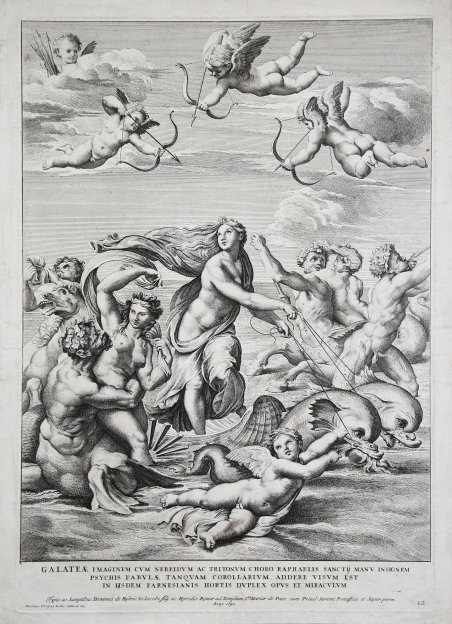Dettagli
Anno di pubblicazione
1693
Descrizione
Il trionfo di Galatea, dall’affresco di Raffaello Sanzio a Villa Farnesina. Galatea in piedi su una mezza conchiglia, guidata da due delfini e circondata da nereidi e tritoni. Acquaforte e bulino, 1693, numerata sulla lastra; inciso in basso al centro: : 'GALATEAE IMAGINEM CUM NEREIDUM AC TRITONUM CHORO RAPHAELIS SANCTII MANU INSIGNEM / PSYCHIS FABULAE TANQUAM COROLLARIUM ADDERE VISUM EST / IN IISDEM FARNESIANIS HORTIS DUPLEX OPUS ET MIRACULUM / Typis ac Sumptibus Dominici de Rubeis Io. Iacobi filii ac Heredis Romae ad Templum Stae. Mariae de Pace cum Privil. Summi Pontificis, et Super. perm. / Anno 1693.'. Firmata in basso a destra: 'Nicolaus Dorigny Gallus delin. et. inc.'. La stampa incisa da Dorigny è parte di una importante impresa editoriale volta a illustrare gli affreschi di Raffaello nella Loggia della Farnesina. La serie edita nel 1693 per i tipi di Domenico di Giovanni Giacomo de Rossi, editore romano che tenne la propria bottega presso la chiesa di Santa Maria della Pace, si compone di 11 tavole incise all'acquaforte tratte dalle scene della Loggia, mentre l'ultima riproduce la Galatea della stanza attigua. Le stampe, provviste di privilegio papale, sono precedute da un frontespizio con il titolo e la dedica al duca di Parma Ranuccio II Farnese, le cui armi araldiche figurano in basso a sinistra. Tutte le incisioni sono numerate e recano nel margine inferiore scritte esplicative in latino desunte dalla favola di Amore e Psiche, descritta da Apuleio nell’Asino d'Oro. La scelta dei testi di commento si deve a Giovan Pietro Bellori, l’erudito classicista e intellettuale di fiducia di Casa Farnese. Le matrici di rame per la serie furono distrutte nel primo Ottocento per ordine di Leone XII (Le Blanc). Magnifica prova, ricca di toni, impressa su carta vergata coeva, con margini, in ottimo stato di conservazione. Bibliografia IFF / Inventaire du Fonds Français: Bibliothèque Nationale, Département des Estampes (31). The triumph of Galatea, after Raphael, with Galatea standing on a half-shell, led by two dolphins and surrounded by nereids and tritons. Numbered on plate; lettered at lower centre: 'GALATEAE IMAGINEM CUM NEREIDUM AC TRITONUM CHORO RAPHAELIS SANCTII MANU INSIGNEM / PSYCHIS FABULAE TANQUAM COROLLARIUM ADDERE VISUM EST / IN IISDEM FARNESIANIS HORTIS DUPLEX OPUS ET MIRACULUM / Typis ac Sumptibus Dominici de Rubeis Io. Iacobi filii ac Heredis Romae ad Templum Stae. Mariae de Pace cum Privil. Summi Pontificis, et Super. perm. / Anno 1693.'; at lower left: 'Nicolaus Dorigny Gallus delin. et. inc.'. Dorigny's engraved print is part of a major publishing venture aimed at illustrating Raphael's frescoes in the Loggia della Farnesina. The series published in 1693 for the types of Domenico di Giovanni Giacomo de Rossi, a Roman publisher who kept his workshop at the church of Santa Maria della Pace, consists of 11 etched plates taken from the scenes in the Loggia, while the last one reproduces the Galatea from the adjoining room. The prints, provided with papal privilege, are preceded by a frontispiece with the title and dedication to the Duke of Parma Ranuccio II Farnese, whose heraldic arms appear in the lower left corner. All engravings are numbered and bear explanatory inscriptions in the lower margin in Latin taken from the fable of Cupid and Psyche, described by Apuleius in Asino d'Oro. The choice of commentary texts is due to Giovan Pietro Bellori, the erudite classicist and trusted intellectual of the Farnese’s Family. The copperplates for the series were destroyed in the early 19th century by order of pope Leone XII (Le Blanc). Etching with engraving, a fine impression, printed on contemporary laid paper, with margins, very good condition. Bibliografia IFF / Inventaire du Fonds Français: Bibliothèque Nationale, Département des Estampes (31). Cfr.

Scopri come utilizzare
Scopri come utilizzare

